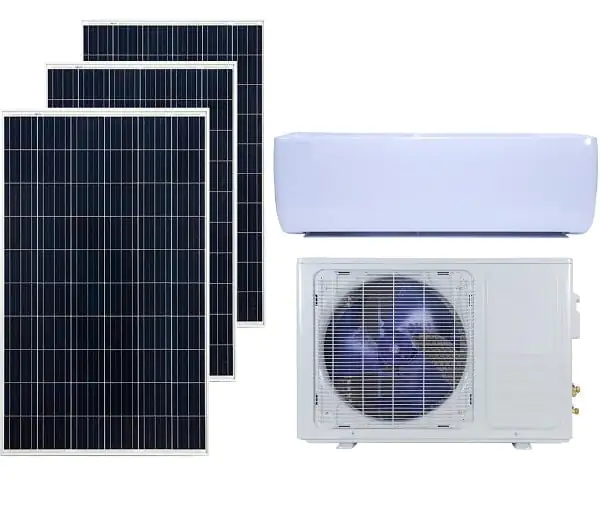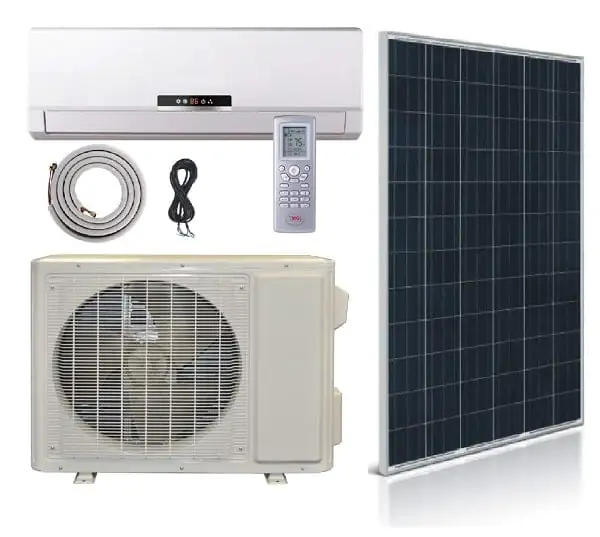Buy 1.5 Ton Air Conditioner | Best Price In India.
The 1.5-ton solar air conditioner is a popular choice for cooling larger residential spaces and small commercial areas. It combines the benefits of solar power with efficient air conditioning technology to provide effective cooling while minimizing energy consumption. In this article, we will explore the features, advantages, installation process, and frequently asked questions related to 1.5-ton solar air conditioners.

Introduction
A 1.5-ton solar air conditioner is specifically designed to cool spaces that require approximately 18,000 British Thermal Units (BTUs) of cooling capacity. It utilizes solar energy as a power source, significantly reducing dependence on the electrical grid and contributing to energy efficiency and cost savings. These air conditioners are suitable for medium-sized rooms, offices, retail spaces, and other areas where higher cooling capacity is needed.
How Does a 1.5-Ton Solar Air Conditioner Work?
The 1.5-ton solar air conditioner operates by harnessing solar power to generate electricity for cooling. Here's an overview of how it works:
-
Solar Panel Absorption: Solar panels, typically installed on rooftops or areas with ample sunlight exposure, absorb sunlight.
-
Conversion to Electrical Energy: The absorbed sunlight is converted into direct current (DC) electricity by the solar panels.
-
Inverter Conversion: An inverter converts the DC electricity into alternating current (AC) electricity, which is compatible with the air conditioning unit.
-
Powering the Compressor: The AC electricity powers the compressor, which pressurizes the refrigerant gas.
-
Cooling Cycle: The pressurized refrigerant gas enters the condenser coil, where it releases heat and condenses into a liquid state.
-
Expansion Valve: The liquid refrigerant passes through an expansion valve, where it expands and evaporates, absorbing heat from the indoor air.
-
Indoor Cooling: The cooled and dehumidified air is distributed throughout the indoor space by the fan system, providing a comfortable environment.
-
Refrigerant Recycling: The refrigerant, now in a gaseous state, returns to the compressor to repeat the cooling cycle.
By utilizing solar power, the 1.5-ton solar air conditioner reduces electricity consumption, lowers carbon emissions, and promotes sustainable cooling.
Solar Air Conditioner Price 2023
| Solar AC Model | Panel Watt | Selling Price |
| 1 Ton Solar Air Conditioner | 1500 Watt | Rs. 99,000 |
| 1.5 Ton Solar Air Conditioner | 2500 Watt | Rs. 1,39,000 |
Advantages of a 1.5-Ton Solar Air Conditioner
-
Energy Efficiency: The 1.5-ton solar air conditioner operates on renewable solar energy, resulting in reduced electricity consumption and lower energy bills.
-
Environmental Friendliness: Solar air conditioners have a lower carbon footprint compared to traditional units, as they rely on clean and renewable solar power.
-
Cost Savings: By utilizing solar energy, these air conditioners can provide long-term cost savings by reducing dependence on the electrical grid and minimizing electricity bills.
-
Reliable Operation: Solar air conditioners often incorporate advanced technology, ensuring reliable operation and efficient cooling performance.
-
Remote Control Functionality: Many models offer remote control functionality, allowing users to adjust temperature settings and fan speed conveniently from anywhere within the range.
-
Quiet Operation: The 1.5-ton solar air conditioner is designed to operate quietly, providing a peaceful and comfortable indoor environment.

Installation Process of a 1.5-Ton Solar Air Conditioner
The installation of a 1.5-ton solar air conditioner involves the following steps:
-
Solar Panel Placement: Determine the optimal location for solar panel installation, considering factors such as sunlight exposure, shading, and structural integrity.
-
Inverter Installation: Install the inverter, which converts the DC electricity generated by the solar panels into AC electricity suitable for the air conditioner.
-
Electrical Connection: Establish the electrical connections between the solar panels, inverter, and air conditioning unit, ensuring proper wiring and adherence to safety standards.
-
Mounting the Air Conditioner: Mount the indoor and outdoor units of the air conditioner at appropriate locations, ensuring proper airflow and accessibility for maintenance.
-
Refrigerant Line Installation: Connect the indoor and outdoor units with refrigerant lines, ensuring secure and leak-free connections.
-
Electrical Integration: Connect the air conditioning unit to the inverter, ensuring proper wiring and compatibility.
-
Testing and Commissioning: Test the system to ensure all components are functioning correctly, including checking refrigerant levels, thermostat settings, and overall performance.
-
User Training: Provide the user with comprehensive training on operating and maintaining the 1.5- ton solar air conditioner, including energy-saving tips.
To ensure a safe and efficient installation, it is recommended to consult with professionals experienced in solar air conditioner installations.
